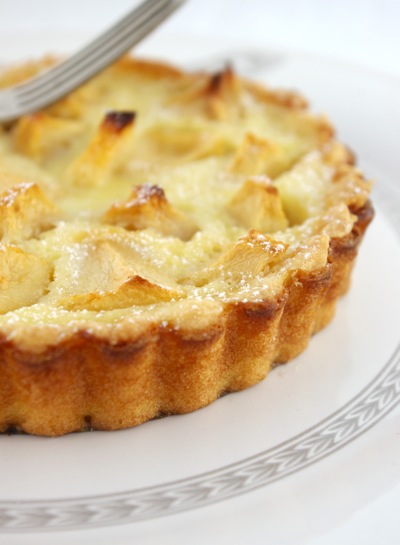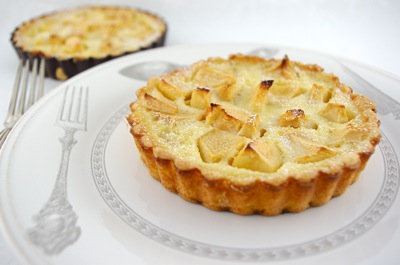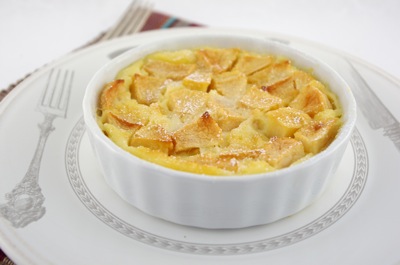My husband gave up all hope of his usual distinguished and discreet passage through the market on Saturday morning as we approached our favorite fruit and vegetable stand. An uncontrollable (or uncontrolled?) squeal of delight escaped my lips as I caught sight of the bounty of newly arrived autumn treats: plump burnt orange pumpkins and squash, roly-poly sweet potatoes, deep chocolate-colored figs nestled snugly together inside their tiny wooden crate. Mushrooms, the common to the uncommon, lay placidly, as mushrooms are wont to do, in piles near the front in elegant, gentle shades of brown and cream and gold while the first clementines made their tentative appearance from sunny Spain. Tumbles of grapes and sacks of chestnuts are the season's harbingers as the sun chases the gray rainy days away and skittles back to town.
I slip my hand into his, my excitement palpable, as visions of autumn's best savory dishes and sweet treats flutter through my head; soups and risotti, pies and cakes. I'm taken back to bright, chilly weekends spent with his parents in their small country village, bundling up in sweaters and coats, dog let off the leash to enjoy a day of complete freedom, skirting around the old stone houses and along the edges of the fields (with a nod towards the occasional cow) and ending up at the apple orchards stretching gracefully into the distance. Finding our way back home, chilled to the bone, our cheeks and noses flushed from the fresh air, to find a pot of hot coffee and a warm apple tart on the table. Or brisk walks through the vineyards outside of Nantes, new city, new dog but the same chill air and bright sun welcome us to yet another autumn as we laugh and chatter among the lush, green branches heavy with fruit, playing tag with a family of deer snuffling among the vines, giggling as Marty pushes his snout into les grappes and elegantly picks grape after grape; even he is hungry for autumn fruit. Home again finds us digging into yet another lovely apple pie.
Advertisem*nt
The apple and pear people are back, as well, taking up their usual market spot outdoors under the eaves. Two vibrant women, hair hurriedly pushed back into scruffy ponytails, old, worn cardigans tucked under heavy blue cotton aprons, dash back and forth from client to bin and back again, selecting from a seemingly never-ending array of apples and pears fresh from the orchards, explaining which are for eating, which baking, which are sweet and which are tart. I glance over the crude wooden crates filled with golden green and red fruit and breath in deeply the wonderful fragrance of autumn as we await the "go ahead" nod of one of the vendeuses. My husband leans in towards her and asks, "what do you suggest for a clafoutis?" and she begins scooping up bright Reines des Reinettes and placing them in her battered plastic tub that sits atop the scale. "Yes, definitely, les Reines des Reinettes," she explains. "You can always use sweet Golden, but Reines des Reinettes add a touch of tartness which, when baked, heightens and brings out all of the apples' full flavor!"
Ever wary of summer stone fruits and the dulling of flavor we have experienced over the past several years, my husband prefers apples and pears grown abundant and closer to home and waits patiently for autumn to roll around. Crisp, sweet apples with a touch of tartness or sweet pears, the flesh soft and meltingly smooth, he will enjoy one at the end of every meal, often pairing his choice with crusty baguette and a salty, creamy roquefort or nutty comté, a tangy goat cheese or an astonishing maroilles, as the French so love to do. And when it comes to dessert, homemade pastries and baked goods, my man gets right to the point: apples or pears! Tarts and galettes, cakes and strudels, he always requests apples or pears. It may simply be the addition of fruit that makes him feel a tad more saintly or a dash less naughty, or it may be that he loves the sweet fruitiness of autumn's best balancing out the cake or crust, but whatever it is this is what he wants. And what my man wants...my man gets.
Advertisem*nt
A clafoutis, as you are well aware, is an egg and cream flan-type treat; a fruit-studded crêpe batter baked and served warm dusted with powdered sugar. This recipe is slightly different, based on a flognarde or flaugnarde, a similar dessert from the Auvergne region of France, where the addition of a splash of oil seems to create a lighter mouthful. And as we associate clafoutis with cherries, the flognarde is usually made with apples or pears. The perfect autumn treat. This is traditionally made without a pastry crust but as I was in the mood for a creamy, fruity tartlet, I baked some of the batter in a Sweet Pastry Crust leaving some in ceramic mini quiche dishes without a crust. They were both perfect.
APPLE CLAFOUTIS
Adapted from a recipe from French Saveurs magazine
Makes 8 - 4 ½-inch (11 cm) tartlet tins/mini quiche dishes*
1 Sweet Pastry Crust (optional)
3 apples - I use crispy, sweet, slightly tart Reine des Reinettes or Goldens
1 ½ cups (350 ml) milk (I use low fat)
3 large eggs
scant ½ cup (90 g) sugar
½ cup + 1 Tbs (70 g) flour
2 Tbs vegetable oil (or any neutral-tasting oil)
Dash vanilla extract* You could also make one large tart or clafoutis, with or without a pastry crust. Or you can use smaller, deeper ramekins.
Prepare your Sweet Pastry crust (you can go here for a recipe and instructions). Wrap the finished dough in plastic wrap and refrigerate for about 30-60 minutes until easy to roll out without sticking too much to the rolling pin. When working with this buttery dough, it is best to work very quickly and handle it as little as possible. Keep your work surface floured as well as dusting the surface of the dough with more flour as needed to keep it from sticking to the rolling pin.
If you are not lining the tins or baking dishes with pastry then generously butter the bottom and sides of each.
Pre-bake your crusts by very carefully rolling out and lining 6 of the tartlet tins. Place the tins on one large baking sheet. Preheat the oven to 375°F (190°C). Place pieces of oven-safe parchment paper or aluminum foil into each pastry-lined tin, fill with uncooked beans or pastry weights and bake for 5 minutes, then remove the paper or foil with the beans and continue baking for another 5-8 minutes until set and golden. Remove from the oven to a cooling rack while you prepare the tartlet filling. Keep the tins (or place the baking dishes) on the baking sheet.
Increase the oven temperature to 400°F (200°C).
Peel and core the apples then cut into chunks. Divide them evenly between the tartlet tins or quiche dishes.
Gently heat the milk until warm. In a medium or large mixing bowl, whisk the eggs until blended and foamy. Add the sugar, flour, oil and vanilla and whisk until smooth. Gradually whisk in the warm milk.
Using a ladle, carefully pour the liquid batter over the apple chunks in the tins, filling almost up to the rim. Carefully lift the entire baking sheet and slip in the preheated oven. Bake for 35-40 minutes until the clafoutis is puffed and golden. If your oven, like mine, bakes unevenly, do not hesitate to flip the baking sheet back to front halfway through the baking time. If changing the size and depth of the tins/ramekins adjust the baking time.
Serve warm dusted with powdered sugar. These are pretty delicious chilled as well.
Jamie Schler lives, eats and writes in France. To read more of her work visit Life's a Feast.



